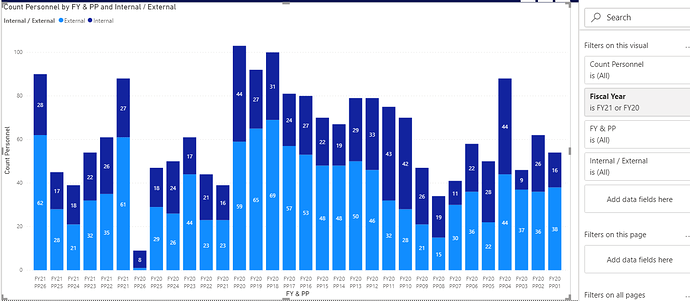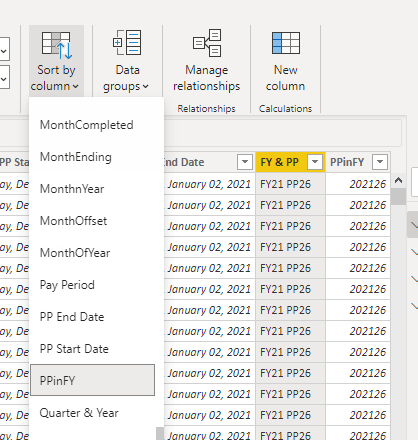@talk2gwhite,
Unfortunately, Power BI doesn’t let you save back into earlier version formats.
I believe that the best way to handle this (other than you upgrading to the December 2020 version), would be in your current version of the file to paste this code below into a new query named StartDates2:
let
Source = Pdf.Tables(Web.Contents("https://www.justice.gov/crt/file/840091/download"), [Implementation="1.2"]),
Table001 = Source{[Id="Table001"]}[Data],
#"Promoted Headers" = Table.PromoteHeaders(Table001, [PromoteAllScalars=true]),
#"Changed Type" = Table.TransformColumnTypes(#"Promoted Headers",{{"Pay Period", Int64.Type}, {"Pay Period Begins (Sunday)", type date}, {"Pay Period Ends (Saturday)", type date}, {"Official Pay Date (Thursday)*", type date}}),
#"Renamed Columns" = Table.RenameColumns(#"Changed Type",{{"Pay Period Begins (Sunday)", "PP Start Date"}, {"Pay Period Ends (Saturday)", "PP End Date"}}),
#"Removed Columns" = Table.RemoveColumns(#"Renamed Columns",{"Official Pay Date (Thursday)*"})
in
#"Removed Columns"
and replace the M code in your Dates table with the following:
//let fnDateTable = (StartDate as date, EndDate as date, optional FYStartMonth as number, optional Holidays as list, optional WDStartNum as number ) as table =>
let
StartDate = #date(2014,1,1),
EndDate = #date(Date.Year(CurrentDate)+1, 12, 31),
FYStartMonthNum = 10,
Holidays = null,
WDStartNum = null,
//Start of the date table code
FYStartMonth = if List.Contains( {1..12}, FYStartMonthNum ) then FYStartMonthNum else 1,
//the WDStartNum parameter allows you to set Weekday numbering running from 0-6 or 1-7 but first day of the week will remain Monday
WDStart = if List.Contains( {0, 1}, WDStartNum ) then WDStartNum else 0,
CurrentDate = Date.From(DateTime.FixedLocalNow()),
DayCount = Duration.Days(Duration.From(EndDate - StartDate))+1,
Source = List.Dates(StartDate,DayCount,#duration(1,0,0,0)),
AddToday = if EndDate < CurrentDate then List.Combine( {Source, {CurrentDate}}) else Source,
TableFromList = Table.FromList(AddToday, Splitter.SplitByNothing()),
ChangedType = Table.TransformColumnTypes(TableFromList,{{"Column1", type date}}),
RenamedColumns = Table.RenameColumns(ChangedType,{{"Column1", "Date"}}),
InsertYear = Table.AddColumn(RenamedColumns, "Year", each Date.Year([Date]), type number),
InsertQuarter = Table.AddColumn(InsertYear, "QuarterOfYear", each Date.QuarterOfYear([Date]), type number),
InsertMonth = Table.AddColumn(InsertQuarter, "MonthOfYear", each Date.Month([Date]), type number),
InsertDay = Table.AddColumn(InsertMonth, "DayOfMonth", each Date.Day([Date]), type number),
InsertDayInt = Table.AddColumn(InsertDay, "DateInt", each [Year] * 10000 + [MonthOfYear] * 100 + [DayOfMonth], type number),
InsertMonthName = Table.AddColumn(InsertDayInt, "Month Name", each Date.ToText([Date], "MMMM"), type text),
InsertCalendarMonth = Table.AddColumn(InsertMonthName, "Month & Year", each (try(Text.Range([Month Name],0,3)) otherwise [Month Name]) & " " & Number.ToText([Year]), type text),
InsertCalendarQtr = Table.AddColumn(InsertCalendarMonth, "Quarter & Year", each "Q" & Number.ToText([QuarterOfYear]) & " " & Number.ToText([Year]), type text),
InsertDayWeek = Table.AddColumn(InsertCalendarQtr, "DayOfWeek", each Date.DayOfWeek([Date]) + WDStart, Int64.Type),
InsertDayName = Table.AddColumn(InsertDayWeek, "DayOfWeekName", each Date.ToText([Date], "dddd"), type text),
InsertWeekEnding = Table.AddColumn(InsertDayName, "WeekEnding", each Date.EndOfWeek( [Date], Day.Monday), type date),
InsertMonthEnding = Table.AddColumn(InsertWeekEnding, "MonthEnding", each Date.EndOfMonth([Date]), type date),
InsertWeekNumber= Table.AddColumn(InsertMonthEnding, "ISO Weeknumber", each
if Number.RoundDown((Date.DayOfYear([Date])-(Date.DayOfWeek([Date], Day.Monday)+1)+10)/7)=0
then Number.RoundDown((Date.DayOfYear(#date(Date.Year([Date])-1,12,31))-(Date.DayOfWeek(#date(Date.Year([Date])-1,12,31), Day.Monday)+1)+10)/7)
else if (Number.RoundDown((Date.DayOfYear([Date])-(Date.DayOfWeek([Date], Day.Monday)+1)+10)/7)=53 and (Date.DayOfWeek(#date(Date.Year([Date]),12,31), Day.Monday)+1<4))
then 1 else Number.RoundDown((Date.DayOfYear([Date])-(Date.DayOfWeek([Date], Day.Monday)+1)+10)/7), type number),
InsertISOyear = Table.AddColumn(InsertWeekNumber, "ISO Year", each Date.Year( Date.AddDays( Date.StartOfWeek([Date], Day.Monday), 3 )), Int64.Type),
BufferTable = Table.Buffer(Table.Distinct( InsertISOyear[[ISO Year], [DateInt]])),
InsertISOday = Table.AddColumn(InsertISOyear, "ISO Day of Year", (OT) => Table.RowCount( Table.SelectRows( BufferTable, (IT) => IT[DateInt] <= OT[DateInt] and IT[ISO Year] = OT[ISO Year])), Int64.Type),
InsertCalendarWk = Table.AddColumn(InsertISOday, "Week & Year", each Text.From([ISO Year]) & "-" & Text.PadStart( Text.From( [ISO Weeknumber] ), 2, "0"), type text ),
InsertWeeknYear = Table.AddColumn(InsertCalendarWk, "WeeknYear", each [ISO Year] * 10000 + [ISO Weeknumber] * 100, Int64.Type),
InsertMonthnYear = Table.AddColumn(InsertWeeknYear , "MonthnYear", each [Year] * 10000 + [MonthOfYear] * 100, type number),
InsertQuarternYear = Table.AddColumn(InsertMonthnYear, "QuarternYear", each [Year] * 10000 + [QuarterOfYear] * 100, type number),
AddFY = Table.AddColumn(InsertQuarternYear, "Fiscal Year", each "FY" & (if [MonthOfYear] >= FYStartMonth then Text.PadEnd( Text.End( Text.From([Year] +1), 2), 2, "0") else Text.End( Text.From([Year]), 2)), type text),
AddFQ = Table.AddColumn(AddFY, "Fiscal Quarter", each "FQ" & Text.From( Number.RoundUp( Date.Month( Date.AddMonths( [Date], - (FYStartMonth -1) )) / 3 )), type text),
AddFM = Table.AddColumn(AddFQ, "Fiscal Period", each if [MonthOfYear] >= FYStartMonth then [MonthOfYear] - (FYStartMonth-1) else [MonthOfYear] + (12-FYStartMonth+1), type text),
InsertIsAfterToday = Table.AddColumn(AddFM, "IsAfterToday", each not ([Date] <= Date.From(CurrentDate)), type logical),
InsertIsWorkingDay = Table.AddColumn(InsertIsAfterToday, "IsWorkingDay", each if Date.DayOfWeek([Date], Day.Monday) > 4 then false else true, type logical),
InsertIsHoliday = Table.AddColumn(InsertIsWorkingDay, "IsHoliday", each if Holidays = null then "Unknown" else List.Contains( Holidays, [Date] ), if Holidays = null then type text else type logical),
InsertIsBusinessDay = Table.AddColumn(InsertIsHoliday, "IsBusinessDay", each if [IsWorkingDay] = true and [IsHoliday] <> true then true else false, type logical),
InsertDayType = Table.AddColumn(InsertIsBusinessDay, "Day Type", each if [IsHoliday] = true then "Holiday" else if [IsWorkingDay] = false then "Weekend" else if [IsWorkingDay] = true then "Weekday" else null, type text),
//InsertDayOffset = Table.AddColumn(InsertDayType, "DayOffset", each Number.From([Date] - CurrentDate), type number), //if you enable DayOffset, don't forget to adjust the PreviousStepName in the next line of code.
InsertWeekOffset = Table.AddColumn(InsertDayType, "WeekOffset", each (Number.From(Date.StartOfWeek([Date], Day.Monday))-Number.From(Date.StartOfWeek(CurrentDate, Day.Monday)))/7, type number),
InsertMonthOffset = Table.AddColumn(InsertWeekOffset, "MonthOffset", each ((12 * Date.Year([Date])) + Date.Month([Date])) - ((12 * Date.Year(Date.From(CurrentDate))) + Date.Month(Date.From(CurrentDate))), type number),
InsertQuarterOffset = Table.AddColumn(InsertMonthOffset, "QuarterOffset", each ((4 * Date.Year([Date])) + Date.QuarterOfYear([Date])) - ((4 * Date.Year(Date.From(CurrentDate))) + Date.QuarterOfYear(Date.From(CurrentDate))), type number),
InsertYearOffset = Table.AddColumn(InsertQuarterOffset, "YearOffset", each Date.Year([Date]) - Date.Year(Date.From(CurrentDate)), type number),
IdentifyCurrentDate = Table.SelectRows(InsertYearOffset, each ([Date] = CurrentDate)),
CurrentYear = IdentifyCurrentDate{0}[Year],
CurrentMonth = IdentifyCurrentDate{0}[MonthOfYear],
InsertFYoffset = Table.AddColumn(InsertYearOffset, "FiscalYearOffset", each try (if [MonthOfYear] >= FYStartMonth then [Year]+1 else [Year]) -
(if CurrentMonth >= FYStartMonth then CurrentYear+1 else CurrentYear) otherwise null, type number),
RemoveToday = if EndDate < CurrentDate then Table.SelectRows(InsertFYoffset, each ([Date] <> CurrentDate)) else InsertFYoffset,
InsertCompletedWeek = Table.AddColumn(RemoveToday, "WeekCompleted", each [WeekEnding] < Date.From(Date.EndOfWeek(CurrentDate)), type logical),
InsertCompletedMonth = Table.AddColumn(InsertCompletedWeek, "MonthCompleted", each [MonthEnding] < Date.From(Date.EndOfMonth(CurrentDate)), type logical),
InsertCompletedQuarter = Table.AddColumn(InsertCompletedMonth, "QuarterCompleted", each Date.EndOfQuarter([Date]) < Date.From(Date.EndOfQuarter(CurrentDate)), type logical),
InsertChangedType = Table.TransformColumnTypes(InsertCompletedQuarter,{{"Year", Int64.Type}, {"QuarterOfYear", Int64.Type}, {"MonthOfYear", Int64.Type}, {"DayOfMonth", Int64.Type}, {"DateInt", Int64.Type}, {"DayOfWeek", Int64.Type}, {"ISO Weeknumber", Int64.Type}, {"WeeknYear", Int64.Type}, {"MonthnYear", Int64.Type}, {"QuarternYear", Int64.Type}, {"Fiscal Period", Int64.Type}, {"WeekOffset", Int64.Type}, {"MonthOffset", Int64.Type}, {"QuarterOffset", Int64.Type}, {"YearOffset", Int64.Type}, {"FiscalYearOffset", Int64.Type}}),
#"Merged Queries" = Table.NestedJoin(InsertChangedType, {"Date"}, StartDates2, {"PP Start Date"}, "StartDates2", JoinKind.LeftOuter),
#"Expanded StartDates2" = Table.ExpandTableColumn(#"Merged Queries", "StartDates2", {"Pay Period", "PP Start Date", "PP End Date"}, {"Pay Period", "PP Start Date", "PP End Date"}),
#"Filled Down" = Table.FillDown(#"Expanded StartDates2",{"Pay Period", "PP Start Date", "PP End Date"}),
#"Filtered Rows" = Table.SelectRows(#"Filled Down", each ([Pay Period] <> null)),
#"Added Custom" = Table.AddColumn(#"Filtered Rows", "FY & PP", each [Fiscal Year]&" PP"& Text.PadStart( Text.From( [Pay Period] ), 2, "0")),
#"Added Custom1" = Table.AddColumn(#"Added Custom", "PPinFY", each "20"&Text.Middle( [Fiscal Year], 2, 2)& Text.PadStart( Text.From( [Pay Period] ), 2, "0")),
#"Changed Type" = Table.TransformColumnTypes(#"Added Custom1",{{"PPinFY", Int64.Type}, {"FY & PP", type text}}),
#"Added Custom2" = Table.AddColumn(#"Changed Type", "PPinYr", each "20"&Text.Middle( Text.From( [Year] ), 2, 2)& Text.PadStart( Text.From( [Pay Period] ), 2, "0")),
#"Changed Type1" = Table.TransformColumnTypes(#"Added Custom2",{{"PPinYr", Int64.Type}})
in
#"Changed Type1"
//in
//fnDateTable
This won’t totally reproduce my file, but it will capture 95% of the work I did and the rest of it (creation of the measure and the column chart) should be easy for you to do once the power query transformations are complete.
– Brian




